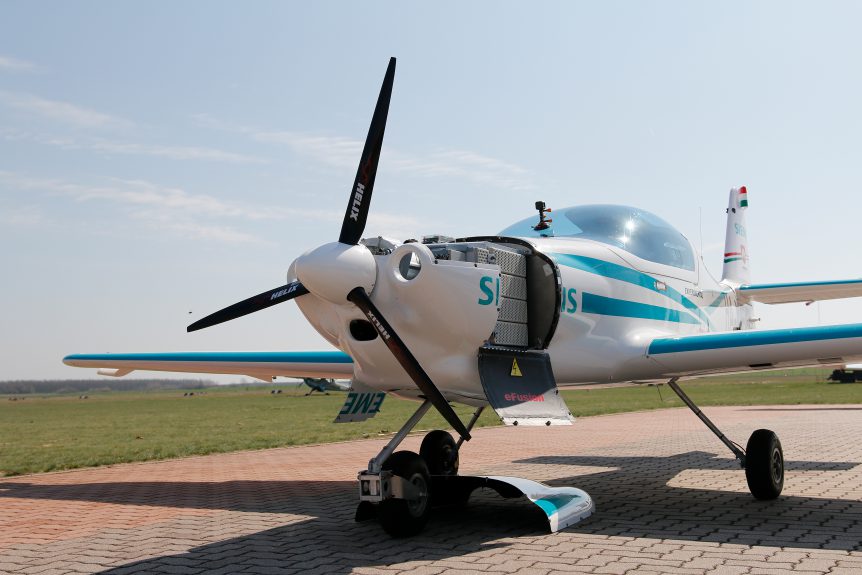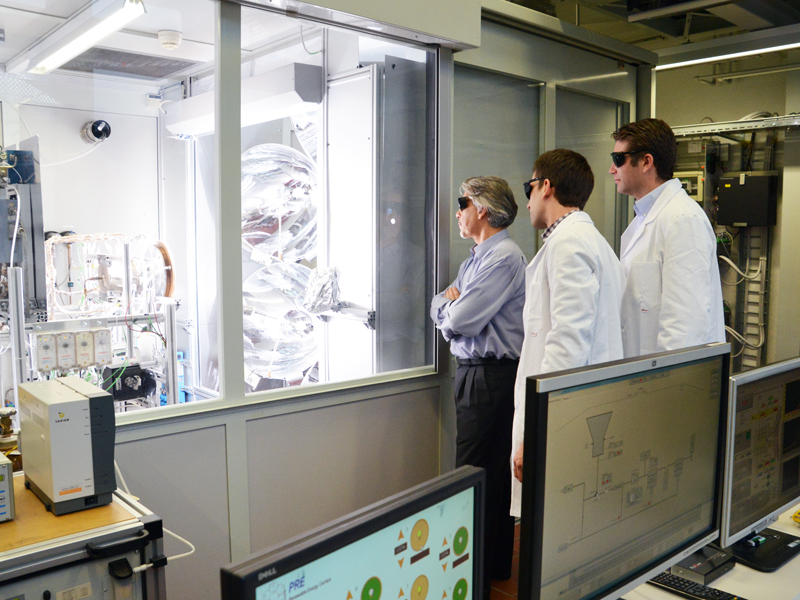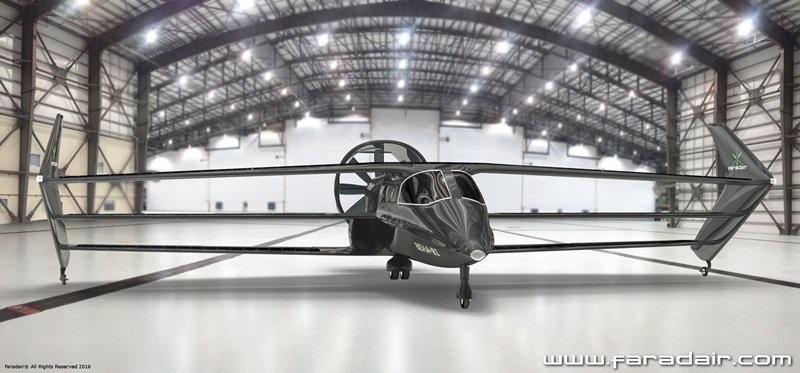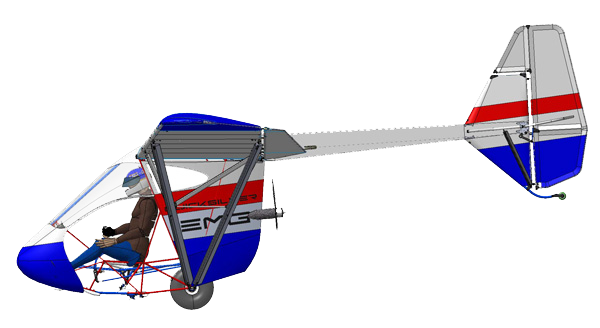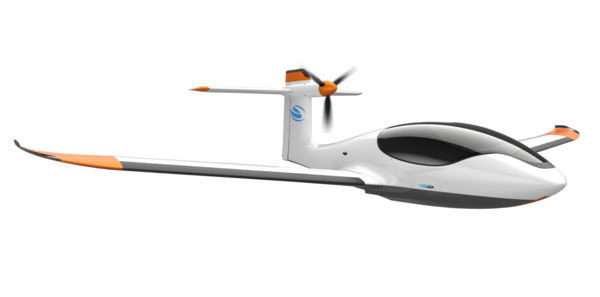A U. S. Debut in Chicago Mary Grady, writing in AVweb, reports that “Siemens brought its prototype electric aircraft to the U.S. this week for the first time, showcasing the airplane at the company’s Innovation Day in Chicago. ‘Electric propulsion is one of the transformative technologies that will help the industry meet the goals of reduced fuel, emissions and noise,’ said Teri Hamlin, vice president of electric propulsion for Siemens. ‘By accomplishing testing on our systems on select flying testbeds in the lower power classes, we are gaining valuable experience and knowledge that accelerates and validates our other developments in hybrid-electric propulsion systems in the high power classes.’“ Testing in Waco Further testing of the technology will take place in Waco, Texas, at the Texas State Technical College Airfield. The eFusion with its Siemens 55-kilowatt electric propulsion unit, “Will be key in data collection on new electric propulsion systems, enabling safety standards and certification efforts for the aerospace market.” Lessons …
Earth, Air, Water and Jet Fire
“I have always loved the desert. One sits down on a desert sand dune, sees nothing, hears nothing. Yet through the silence something throbs, and gleams.” Antoine de Saint-Exupéry, The Little Prince The SOLAR-JET project (Solar chemical reactor demonstration and Optimization for Long-term Availability of Renewable JET fuel. or SOLAR-JET) pulls carbon dioxide from the air, mixes it with water and exposes the mix to 1,500 degree (Centigrade) concentrated solar energy and makes a synthetic natural gas, with oxygen as the only exhaust. Attempting to produce a useable fuel from CO2 has been an obsession for many over several decades. Attempts to capture and store CO2 are expensive and usually only hide the carbon, ostensibly for eternity. SOLAR-JET explains its objectives on its web site. “The aim of the SOLAR-JET project is to demonstrate a carbon-neutral path for producing aviation fuel, compatible with current infrastructure, in an economically viable way. Because the process hopes to pull CO2 from the atmosphere, the …
Toyota, BMW Fahrting Around with Clean Energy
Fahrt is German for drive, to clear things up immediately. Both Toyota and BMW are experimenting with the cruder form of the word, though, to bring about greener, cleaner driving. Both have bio-energy plans that use animal and even human waste to generate methane – a greenhouse gas that when burnt, combats air pollution. Variations on the theme may someday power our aircraft. Harold Bate and a Little Prehistory This is not a new idea. Harold Bate, a Devonshire farmer, became a counter-culture hero in the 1970s by powering his Hillman Minx sedan with manure. Like all visionaries, Harold was a bit ahead of his time, but became well known and envied when the Arab oil embargo of that decade left motorists waiting in line for fuel and confronted with rationing for the first time since WWII. The charming film from the National Film Board of Canada highlights the simplicity of his homegrown approach and the depth of his understanding. …
Faradair BEHA, an Electric Triplane for the Future
Triplanes were popular in World War One because they allowed great maneuverability for dog-fighting, a supreme survival necessity. Their success in designs by Fokker and Sopwith, among others, gave them a certain panache. Now, a Bristol, England-based company hopes to revive the triplane as a commuter aircraft ready to fly from regional airports. Faradair®, named after English physicist Michael Faraday*, hopes to craft an airplane that will allow flight from smaller regional airports and compete with even well-established rail service. Their craft, BEHA – Bio-Electric Hybrid Aircraft, will fly six to eight lucky passengers on a quiet inter-city ride powered by a 300-horsepower internal combustion engine and two electric motors in a parallel-hybrid arrangement. Neil Cloughley, Managing Director and Founder of Faradair, wants to return Britain’s regional air services to a point where they were between WWI and WWII, when a small group of passengers could board a DeHavilland Dragon Rapide for a leisurely and sight-filled journey over England’s green …
Making Hydrogen at Ambient Temperature with Biomass
Hydrogen would be a nearly perfect fuel if it didn’t take more energy to extract it than you can get out of it. Scientists have been working for years to isolate it in an economical fashion. The most common element in the universe, hydrogen makes up 10 percent of the weight of living things here on earth – mainly in water, proteins and fats. Its bonds in water make it pervasive, but still distant. Obtaining it can be as simple as the video below. But the short bursts derived from this approach will exhaust the battery and not provide as much energy in return. Waste Not, Want Not Ironically, much of the earth’s other resources, more easily gained, are wasted in our society’s rush to consume. Recent reports show that up to a third of the food produced today goes to waste. Huge quantities of biomass could seemingly be put to good use rather than adding to the methane that …
Renewable Biomethane – an Economic Alternative?
Compressed natural gas (CNG) has several things going for it. It is cheaper than gasoline or diesel fuel, has lower emissions, and for a conventional piston-engined airplane, is the equivalent of over 130 octane, far more powerful than 100-octane low lead (100LL) and cleaner burning. CNG Fuels in England CNG filling stations are growing across the country as fleet owners take advantage of the economics of converting their vehicles, but are still few and far between in the west, with the exception of California. There are under 900 stations throughout America. Alluring as CNG might be for drivers, pilots used to paying $5.50 per gallon for avgas should be charmed by CNG’s price of $1.00 per gallon equivalent. That is with conventional, fossil-based CNG, basically a storable version of natural gas. That leads to its less-desirable characteristics. First, it pollutes, too, and is a source of greenhouse gases. Second, natural gas has a hard time overcoming its association with fracking, …
Gleaning the Forests for Jet Fuel
Three congresspeople flew on wood-waste fumes this week, aboard an Alaska Airlines Boeing 737-800 on its way from Seattle-Tacoma International Airport (SEATAC) to Washington, DC. It was the first commercial flight to “to be powered by a blend of renewable jet fuel made from forest residuals.” Waste Products Replace Fossil Fuels Alaska, Boeing, and SEATAC have partnered on including biofuels in the mix since early 2015, as reported here. Later that year, United made flights out of Los Angeles International (LAX) using a blend of fossil-based jet fuel and biofuels made from farm and municipal waste. Keeping waste out of landfills and producing a lower carbon-footprint fuel has several benefits. In the case of forest waste, those branches, limbs and twigs that litter the forest floor after a timber harvest, cleaning that debris away lowers fire risk in the warm seasons and makes renewable isobutanol. Developed through a five-year project led by Washington State University and the Northwest Advanced Renewables …
A 24-Volt Airplane Motor?
One of the big surprises in last month’s webinar hosted by the EAA and presented by Brian Carpenter of Rainbow Aviation Services/Adventure Aviation was the 24-Volt motor being developed for the EMG-6 ultralight motorglider. High and Low Voltages Many, if not most of the electric motors flying on existing craft are higher voltage units. For sake of an off-handed definition, we’ll divide low and high at below and above 50 Volts, something OSHA delineates in its regulation 29 CFR 1910.303(g)(2)(i), which “generally requires “’live parts of electric equipment operating at 50 volts or more’ to be ‘guarded against accidental contact by use of approved cabinets or other forms of approved enclosures’ or by other specified means.” In its explanation, the Occupational Safety and Health Administration “considers all voltages of 50 volts or above to be hazardous. Electric current, not voltage, passing through the human body causes injury….” And it really doesn’t take much amperage to take a person to the …
First motor Test Run for Equator P2
The Equator P2 is a hybrid amphibious two-seater that looks like the future. Under development for a decade, this amateur-built machine looks highly professional, surpassing in form and function many of its factory-built peers. It had its first motor run-up recently, a much-anticipated event that met all expectations. Looking Like the Future, Built in a Garage One can see the garage-built home of the craft in the simple bracing used to hold the tail-mounted motor in place, an example of the truly hand-made nature of the Equator prototype. The rudimentary surroundings fail to show the sophistication of the design, however, including a power system similar to that used on the range-extended e-Genius. Progress over the last nine years has been limited, as with many such projects, by (in Tine Tomazic’s words)”the speed of cash.” As with other such projects, the family car occupies the driveway, the Equator the garage. Tomas Brodreskift designed the craft while serving an internship with Airbus. …
Nissan’s SOFC Vehicle – Just in Time for the Olympics
Two major types of fuel cells vie for vehicle designers’ attention: PEM, or proton exchange membrane types, and solid oxide fuels cells (SOFCs). PEMs (also known as polymer electrolyte membrane fuel cells) require an expensive catalyst such as platinum, and hydrogen as fuel. Hydrogen itself is costly to produce and runs up the operating cost for such a fuel cell. Nissan Motor Co., Ltd. timed things to coincide with the 2016 Olympics opening in Rio de Janeiro, Brazil for the introduction of their solid oxide fuel cell vehicle, a van that runs on bio-ethanol electric power. Nissan’s Carlos Ghosn claims this to be a first, with benefits for potential users. “The e-Bio Fuel-Cell offers eco-friendly transportation and creates opportunities for regional energy production…all the while supporting the existing infrastructure. In the future, the e-Bio Fuel-Cell will become even more user-friendly. Ethanol-blended water is easier and safer to handle than most other fuels. Without the need to create new infrastructure, it …

